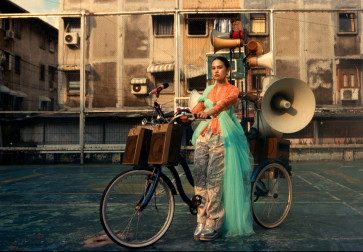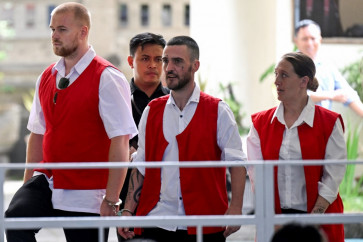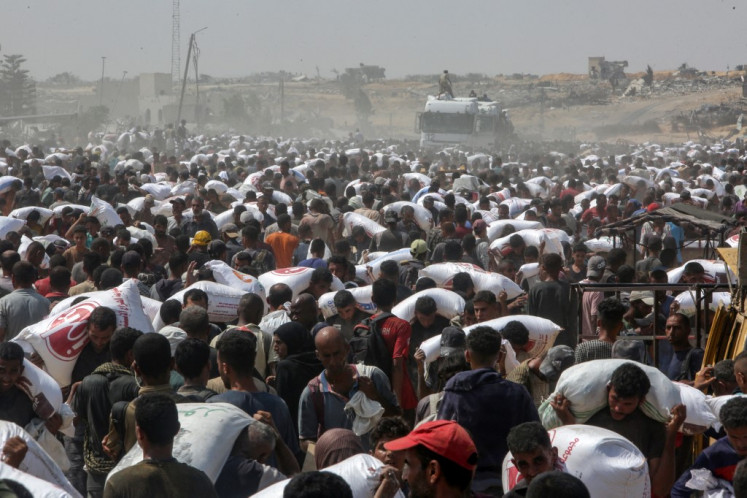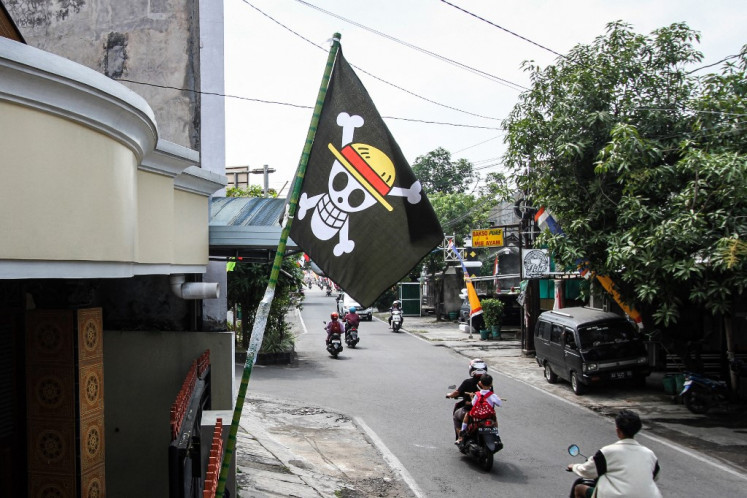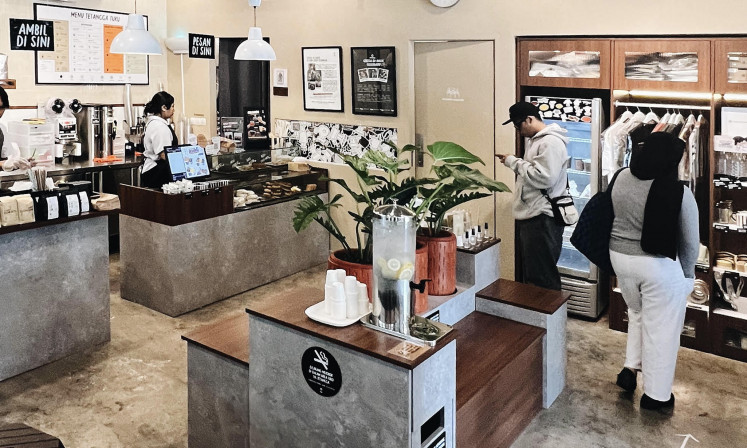Popular Reads
Top Results
Can't find what you're looking for?
View all search resultsPopular Reads
Top Results
Can't find what you're looking for?
View all search resultsDawn in Banjarmasin
Meeting place: People congregate at dawn at Banjarmasin’s floating market, Pasar Kuin
Change text size
Gift Premium Articles
to Anyone
Meeting place: People congregate at dawn at Banjarmasin’s floating market, Pasar Kuin. JP/Deanna Ramsay
The sound of the boat’s crude motor seemed to reverberate along the Martapura River, a little grating for 5 a.m.
But, cruising along the pre-dawn waterways of Banjarmasin in South Kalimantan, past homes standing on stilts just meters away, no one in the area seemed to notice.
Riverside residents continued to brush their teeth, bathe and do laundry as boats slid past, returning home from all-night labors loaded with goods, or — like this one — heading toward the Barito River just before it meets the Java Sea.
Some call Banjarmasin the Venice of the East, a statement that rings both true and false as one meanders along the city’s many waterways.
Banjarmasin is crisscrossed with a network of rivers and canals and situated in a strategic position for trade, much like Venice, Italy.
But, that is where the similarities end. For Banjarmasin’s commercial activities have developed from the rich resources available in Kalimantan’s forests. Coal, timber, rubber and palm oil — the world’s desire for Kalimantan’s valuable commodities continues to alter the area.
Entering the Barito from a tiny tributary just as dawn was beginning to break, the river was nothing but majestic, and clearly a center of activity.
Massive ships stood parked along the Barito’s banks next to stacks of giant logs being readied for processing and transport.
Water world: Buying and selling at a small pasar (market) occurs above one Banjarmasin canal.JP/Deanna Ramsay
Up ahead, smaller boats could be seen congregating next to even more logs floated down from upriver. That humbler collection of boats — later to swell to many more — was Banjarmasin’s famous floating market, Pasar Kuin.
Men and women with mangoes, coconuts and bananas piled high expertly navigated their tiny boats between larger ones filled with curious visitors that continued to arrive as the sun emerged over the horizon.
Enthusiastic newcomers snapped photos of the scenery while purchasing coffee from floating stalls featuring sweet and savory breakfasts. If one’s boat managed to get a coveted spot next to one popular floating warung, a stick with a nail at the end comes into play, a unique device for skewering one’s desired meal.
It was a festive atmosphere there on the river at dawn, people laughing and jumping from boat to boat for photo ops and local children balancing precariously among the floating logs, occasionally diving into the water, while vendors wove back and forth, focusing on sales.
River life: Homes resting on stilts can be seen while sailing down Banjarmasin’s tiny waterways. JP/Deanna Ramsay
Kalimantan has come to prominence recently after the UN’s Reducing Emissions from Deforestation and Forest Degradation (REDD) initiative, a plan to reduce greenhouse gas emissions by creating incentives for developing countries to protect forests instead of clear them. And, Norway famously promised US$1 billion to Indonesia if the country can institute a two-year moratorium on the clearing of forests.
Kalimantan is one of the focal points in these discussions, with its vast natural spaces increasingly turned into palm oil and rubber plantations or transformed for mining.
In December 2010, President Susilo Bambang Yudhoyono selected Central Kalimantan as a priority for the REDD plus plan, which takes REDD a step further by also emphasizing the sustainable management of forests. As the pilot province in this initiative, no new permits to convert primary forest and peatland may be issued.
Indonesia has the third largest expanse of tropical rainforest in the world and half of the world’s tropical peatland, and Kalimantan possesses the majority of the country’s remaining peatland — 3 million hectares.
Considering the ambitious attempts at conservation in the region amid the cargo ships looming along a river laden with coal and timber from Kalimantan’s interior, one wonders what will and can change, as Indonesia’s vow to halt its forest conversions has come under fire, first over delays in implementation and groups later asserting that the country is continuing to issue conversion permits and forests continue to illegally be razed.
A languid afternoon trip along Banjarmasin’s smaller waterways presents another portrait of the area’s milieu. Tiny channels large enough for only two small boats to pass are lined with homes and small mosques.
Children cannonball into the water while adults chat and continue with the laundry. It is steamier
than at dawn, and the many children splashing around seem to have the right idea.
Our guide that day remarked that people living along the river rarely get sick, a statement that may seem incongruous except that one cannot help but notice the deep brown of the water, the piles of trash floating amid the happy swimmers or the rickety outhouses positioned adjacent to homes where river water is part of everyday life.
Ducking way down while passing underneath petite bridges, the atmosphere at sundown deep in Banjarmasin’s river kampungs stands in contrast to the bustle on the massive Barito, Indonesia’s widest river.
Instead of immense tree trunks and ships, there was an occasional group of ducks or a motorless boat being paddled about, even some sites of almost desolate silence with eagles flying listlessly overhead. People go about their day, preparing dinner, heading to the mosque or having a quick mandi, always near these gently flowing waters of Banjarmasin. Our guide said life along the river had not changed that much in decades.
One small canal led out onto a wider section of the Martapura — Banjarmasin’s other main waterway — and just at sunset a certain sleepiness enveloped an area near hulking rusted ships and children diving off makeshift piers.
For sale: All sorts of goods are transported by boat in Banjarmasin. JP/Deanna Ramsay
Floating along this juncture of tiny tributary and major river, a visit to Banjarmasin leaves much to ponder. The city itself stands at an intersection — both literal and metaphorical — as local residents live and work along increasingly polluted rivers that transport valuable products from Kalimantan’s interior, sites that continue to be marred as they are debated on the international stage. With the increasing desire to protect the area’s natural resources and combat global warming, competing interests are vying to shape the region.
Friends had warned before the journey to Banjarmasin that the city (and its rivers) was blemished by industrial activities and there was not that much of interest, yet the scenes of massive industry that are impossible to ignore are just as riveting as those sights of people immersed in their lives along the water, living in homes balanced precariously on wooden beams, many interlaced tiny canals their backyards.
Stabbing a round of bread stuffed with toasted coconut, a Banjarmasin delight, while laughingly balancing on a rickety boat as the carcasses of Kalimantan’s rainforests stand stacked in the background may seem like somewhat incompatible tableaus, but perhaps the scene is less juxtaposition and more eerie
reality, the disturbing harmony proof that this is what Kalimantan is all about.
One can only wait and see what is next for this vibrant region of Indonesia, Banjarmasin still managing to retain an otherworldly charm amid so many very this-worldly concerns.





